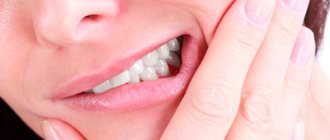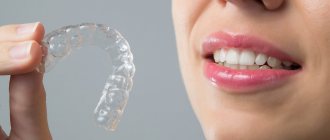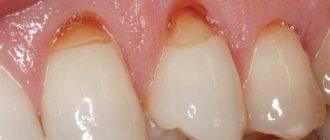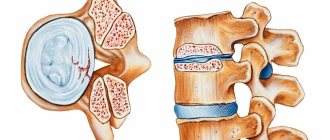- Published by: Laima Jansons
The appearance of any pigmentation on the lips should not be ignored . If a blue dot appears on the lip, even more so. Because this always indicates the presence of malfunctions in the body.
Interesting! Doctors distinguish between two main types of spots - youthful and senile. Both cases have their own characteristics and causes. Before starting treatment for a defect, you should understand what caused it to appear.
Causes of dots on lips
Spots and dots on the lips can vary in size, shape and color. However, special attention should be paid to blue, intensely pigmented dots, since most often they appear as a consequence of serious diseases :
- Disorders of the liver and adrenal glands . Spots and dots on the lips in this case are similar in appearance to chloasma that appears on the face during pregnancy;
- Worm infestation . Pigmentation defects on the lips can be caused by the presence of parasites in the body;
- Peutz-Jeghers syndrome . This is a serious disease, the main symptom of which is the appearance of dots on the lips that look like freckles. The patient develops polyps up to 5 cm in size in the intestines. The syndrome is inherited;
- Melanomas on the lips appear after prolonged exposure to the sun and too frequent visits to the solarium . Such a defect can cause malignant degeneration of cells and cause the development of oncology ;
- Hormonal disorders . Blue spots and dots on the lips may appear due to long-term use of hormonal contraceptives;
- Venous lake . This defect appears on sun-damaged lips and is more common in older people. Sometimes these formations can be quite painful;
- Wart (papilloma) . This unpleasant defect can appear not only on the body, but also on the lip. There are many types of warts, and each case requires special treatment, including surgery.
Photo 1: Brown and blue spots often appear on the lips of smokers, usually on the lower lip. The spot has a pronounced color, its diameter does not exceed 1 cm. Sometimes the spot may look like a small tubercle or nodule under the skin. Source: flickr (Adrian Trenholm).
SUMMARY FROM D.S.:
This study shows that age spots on the genitals are, in the vast majority of cases, NOT DANGEROUS. However, researchers note a possible increased risk of developing skin melanoma (not just the genitals, but also other areas) in people with genital melanosis. This means that if you have similar pigment spots, they must be examined annually with a dermatoscope by an oncologist or dermatologist, just like ALL other pigmented skin formations.
Treatment of blue spots and dots on lips
Only a doctor can make a correct diagnosis and prescribe treatment in each specific case.
Spots that appear due to the harmful effects of ultraviolet rays can be successfully eliminated with the help of bleaching agents and appropriate vitamin complexes.
If the spots are intensely colored , injections of ascorbic acid help well. The appearance of a large number of blue dots on the lips (hyperpigmentation) requires oral administration of folic acid, aevit and riboflavin.
If any other diseases are discovered during research, the intervention of specialists in the required field is required - oncologists, gastroenterologists, dermatologists. Treatment in this case will be comprehensive, and as your overall health improves, the blue spots will disappear on their own.
Photo 2: Treatment of any pigmentation on the lips depends on the causes of the defect, so first of all you will need to undergo an examination and a blood test. Source: flickr (Dave Black)
Diagnosis of a tumor by a doctor in a hospital
What does lip cancer look like? It could be a small ulcer or a widespread tumor. Doctors at the Oncology Clinic of the Yusupov Hospital make a diagnosis of lip cancer based on the patient’s complaints, the results of an external examination and additional studies. The oncologist carefully examines and palpates the lips, cheeks, gums and regional lymph nodes. When examining the red border of the lips, skin and mucous membrane, use a magnifying glass.
How to identify lip cancer? Further examination is carried out using instrumental and laboratory diagnostic methods:
- Ultrasound examination;
- X-rays of the lower jaw;
- Panoramic tomography;
- Cytological examination of material obtained by taking fingerprint smears from the surface of the ulcer or histological examination of tissue obtained during a biopsy.
For lip cancer with lymphatic metastasis, a biopsy of the lymph nodes is performed. To exclude hematogenous metastases, chest X-ray and ultrasound examination of the abdominal organs are used. When the diagnosis of lip cancer is confirmed, an X-ray examination of the chest organs, general clinical and laboratory examination (electrocardiography, blood and urine tests) are performed.
A PET-CT study (positron emission computed tomography) is prescribed for the following purposes:
- Determining the stage of lip cancer;
- Assessment of response to treatment;
- Detection of disease relapse during the observation period.
PET-CT is an innovative method that combines the capabilities of computer technology and radiology. At the Yusupov Hospital, it is used not only to diagnose lip cancer, but also to monitor tumor development and evaluate the outcome of treatment. Thanks to PET-CT, radiologists have the opportunity to very accurately carry out radiation treatment, significantly reduce the irradiation area, and minimize the impact on healthy organs and tissues.
In many cases, the use of PET-CT excludes a number of additional studies in the future. This allows patients of the Yusupov Hospital to save time and money. The issue of the need to use this method is decided individually for a specific patient at a meeting of the expert council with the participation of professors and doctors of the highest category. A comprehensive examination of patients using the latest diagnostic equipment, the use of modern methods of performing laboratory tests using high-quality reagents allows oncologists at the Yusupov Hospital to obtain reliable results and provide adequate therapy for lip cancer at an early stage.
Homeopathic medicines
The success of homeopathic treatment, first of all, lies in an individual approach to each patient. The homeopathic doctor prescribes a drug suitable for the constitutional type of the patient . In this case, the chosen remedy will affect the health of the body as a whole .
Depending on the type of stain on the lip and the patient’s psychotype, the following drugs may be prescribed:
- Arnica (Arnica montana). The drug promotes the resorption of compactions and is used to treat warts and venous nodules on the lips. The constitutional type of Arnica is full-blooded, good-natured people. Most often they are friendly, but during illness they become moody and irritable.
- Calcarea fluorica. Effectively fights vascular tumors, increases the tone of capillaries and blood vessels, and helps in case of helminthic infestation. Prescribed to patients with malocclusion and severe asymmetry of the bone skeleton.
- Silicea . The product effectively fights papillomas and helps eliminate hyperpigmentation on the lips. Psychotype - thin, sickly people who tend to get nervous over trifles. They often freeze and do not tolerate mental stress well.
- Phosphorus (Phosphorus). The drug is prescribed if the appearance of defects on the lips is caused by dysfunction of the liver and adrenal glands. The constitutional type of the drug is tall, stooped people with soft blond hair. The character is sensitive, touchy and vulnerable.
- Bellis perennis. The drug fights the manifestations of excessive pigmentation on the lips and has whitening properties. Most often prescribed to older people who complain of constant fatigue and memory problems.
The popularity of homeopathic treatment is primarily due to the proven effectiveness of the drugs . In addition, the absence of side effects that often occur when using traditional medications can be considered a big plus. Any drug is prescribed individually by a homeopathic doctor , therefore, when a blue dot appears on the lip, consultation with a specialist will be the first step towards a successful cure.
Symptoms
Many patients mistake the first signs of lip cancer for a rash characteristic of an exacerbation of herpes: a small seal forms on the lip, in which a slight itching is felt. At the same time or even a little earlier, the lymph nodes of the chin enlarge. As the tumor develops, the following appear:
- small painless ulcers, covered with a crust, with a bleeding, tuberous base;
- cracks and crusts along the red border of the lip;
- a compaction that grows in size over time and becomes crusty;
- pain in affected soft tissues;
- increased secretion of saliva;
- difficulty eating, deterioration of diction.
If left untreated, the tumor penetrates the tissues of the jaw and begins to destroy them. Simultaneously with the local symptoms of lip cancer, manifestations common to all types of cancer develop: general weakness, decreased performance, decreased appetite, unmotivated weight loss.
Exfoliating treatments
One of the methods to combat hyperpigmentation is a variety of peelings:
- phytic;
- mandelic acid;
- alpha hydroxy acids;
- retinol, etc.
For photoaging, medium peeling with TCA (trichloroacetic acid) will be most effective, for post-acne - salicylic, and for melasma - pyruvic.
One of the popular methods of injection cosmetology is biorevitalization using components that lighten melanin.
What groups of ingredients are used to lighten skin?
Representatives of these groups should be sought in the compositions of combination drugs.
- Tyrosinase inhibitors – azelaic acid, arbutin, flavonoids, resveratrol .
- Destruction and reduction of melanosomes: niacinamide, soy extracts .
- Inhibition of DOPA and dopaquinone synthesis: kojic acid.
- Exfoliation of the stratum corneum: AHAs and retinoids.
- Stimulation of the conversion of melanin to leukomelanin: vitamin C, E and glabridin.
Summary : to effectively lighten pigmentation and reduce the likelihood of side effects, it is more advisable to use combined preparations containing ingredients from different groups.
Laser therapy
A modern, highly effective method of removing pigmentation is laser technology. The method of laser therapy for HSV is based on the phenomenon of photothermolysis - the ability of pigment cells to absorb the energy of a laser beam, which subsequently leads to their destruction. The laser targets the chromophore-melanin found in melanocytes, keratinocytes or macrophages.
According to scientific studies, in more than 45% of patients, the manifestations of IGP disappeared after laser therapy, and in 35% of cases, lightening of the spots was noted.
Although in most cases the effectiveness of laser therapy for VGP is quite high and 1–3 sessions are enough to completely remove spots, constant exposure to UV rays on the facial skin leads to recurrence of VGP 3–4 years after successful treatment. Therefore, the therapeutic complex includes:
- daily use of medications or medicinal cosmeceuticals with a whitening effect for a long time;
- regular use of photoprotective products, even on a cloudy city day;
- professional manipulations aimed at enhancing desquamation (exfoliation) of the epidermis and destruction of melanin-containing cells.
A universal method for treating skin hyperpigmentation has not yet been developed, but over the long history of research and treatment of pigmentation disorders, experience has been accumulated in the use of a variety of correction methods, including a range of remedies from external applications and ointments to high-tech invasive procedures using surgical methods of dermabrasion and high-intensity laser radiation.
Our clinic’s specialists are proficient in various methods for removing skin hyperpigmentation and will help you choose a set of drugs and procedures that are most suitable for the skin type and individual characteristics of each patient.










